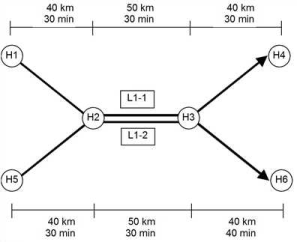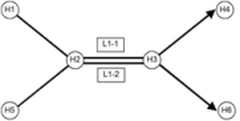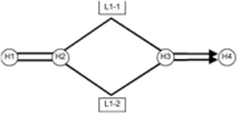Coupling means connecting cars of two or more trains on a line route section. The figure shows several examples of coupling two or three vehicle journeys. In order to link two vehicle journeys on a section, they should match to a certain extent in terms of their spatial and time dimension. The following conditions must be fulfilled:
- The run and dwell times of the time profiles are the same within the coupling section. For correction purposes, run and dwell times may be transferred between time profiles on the level of time profiles.
- The departure times of journeys is the same at the start of the coupling section.
|
|
|
|
|
|
Illustration 24: Examples: Coupling two and three line routes
The number of vehicle journeys and their departure times from From/To Stop Points of coupled sections may deviate. Missing vehicle journeys are generated.
In Visum, coupled vehicle journeys form a coupling group. If time profiles are changed in terms of run times or dwell times, the coupled time profile is automatically adjusted.
Creating and editing couplings
Couplings are always defined based on the level of vehicle journeys. This is why couplings are created and edited on the basis of the tabular timetable. It is assumed that one or several linkable vehicle journeys have been marked.
Based on the selection and different properties, such as the same course within the coupled section selected, overlapping valid days, or the same operator or transport system, further vehicle journeys which could also be coupled will be suggested. Run and dwell times may be transferred between time profiles on the level of time profiles.
Coupling when calculating the PuT operating indicators
Couplings in some cases have an effect on the calculation of PuT operating indicators (Impact caused by couplings). On which indicators exactly they have an effect can be found in the file Indicator availability.xls in your Visum installation. The effect on coupling is illustrated by some examples.
- Service time of the line route
As for kilometers, the service time is only calculated once and distributed evenly.
- Infrastructure cost of the line routes for links and stop points
Link costs (for example rail track cost) and stop point costs are considered only once. These costs are distributed evenly to the coupled line routes.
- The number of line services and vehicle kilometers per link are only counted once.
As service-km, service-time and the infrastructure cost influence the operating cost of a line route, coupled line routes usually result in lower costs.
Coupling does not have an impact on line blocking or assignments.
During assignment, changing seats within a coupled line is thus regarded as a regular transfer between line routes.

Illustration 25: Calculation example for the calculation of indicators in case of couplings
|
Number of trips |
10 trips |
|
Empty time |
10 min/trip |
|
Costs per kilometre |
1 euro/km |
|
Costs per hour |
60 euros/h |
|
Track price |
1 euro/km |
|
Seat capacity |
100 seats/vehicle combination |
|
|
Not coupled |
Not coupled |
Coupled |
Coupled |
|
Line route |
L1-1 |
L1-2 |
L1-1 |
L1-2 |
|
ServiceKm |
1,300 km |
1,300 km |
1,050 km |
1,050 km |
|
SeatKm |
13,000 km |
13,000 km |
13,000 km |
13,000 km |
|
Service time |
900 min |
1,000 min |
750 min |
850 min |
|
Out-of-depot time |
1,000 min |
1,100 min |
850 min |
950 min |
|
Cost |
1,300 EUR |
1,300 EUR |
1,050 EUR |
1,050 EUR |
|
Cost |
1,000 EUR |
1,100 EUR |
850 EUR |
950 EUR |
|
Track costs |
1,300 EUR |
1,300 EUR |
1,050 EUR |
1,050 EUR |
|
Total cost |
3,500 EUR |
3,600 EUR |
2,950 EUR |
3,050 EUR |
|
Num Vehicle journeys |
10 |
10 |
10 |
10 |
|
Link |
H2-H3 |
H3-H4 |
H2-H3 |
H3-H4 |
|
ServiceKm |
1,000 km |
400 km |
500 km |
400 km |
|
Num Vehicle journeys |
20 |
10 |
10 |
10 |
Chained up vehicle journey sections
Chained up vehicle journey sections represent the Forced Chaining and Passenger Trip Chain concepts in the data model. They are mapped in the data model using the same objects, however affecting it in different ways.
- Forced chainings imply that, for operational reasons, all bound vehicle journey sections should always be served by an identical vehicle. In line blocking, it is an a priori specification, which means that the vehicle journey sections are always allocated to the same block.
- Passenger trip chains model situation where, from the passenger's point of view, no transfer is needed in case of a transition between two vehicle journeys. This is the case when two lines of a tram network are linked to each other as part of a loop, for example. At the stop linking the two lines, the line name will change so that a new vehicle journey necessarily starts from here. Through passenger trip chains, these vehicle journey transitions are not counted as transfer with the corresponding impedance values (transfer penalty, delay,...) in the timetable-based assignment, the skim calculation and the shortest patch search, for example.
Both types of chained up vehicle journey sections may occur together. In practice, a passenger trip chain is always also a forced chaining and applies to both:
- The coupling may vary every day on which the vehicle journey section is served.
- The stop points for arrival and departure of the vehicle journey sections involved must be the same (or at least belong to the same stop).
- The bound vehicle journey sections do not have to belong to the same line. The bound lines may even be allocated to different transport systems and operators.
- The coupling links to the departure within the period of arrival until 23h 59m 59s after arrival – independent of transfer walk times, etc.
For the fare calculation, two vehicle journey sections that are linked by passenger trip chains are regarded as two separate path legs. The fare is then calculated on the basis of the fare system's path leg regulation. When determining the fare points, the calculation is not based on the stop's fare points for boarding and alighting, but for passing through.





